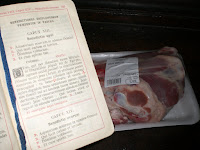Sunday, March 30, 2008
I vote McCain...
http://news.yahoo.com/s/ap/20080330/ap_on_re_eu/vatican_muslims
And hope from the New World:
http://www.johnmccain.com/
God bless America.
Saturday, March 29, 2008
FSSP Roman Easter Vigil...
FSSP Roman Easter Vigil...
FSSP Roman Easter Vigil...
Catholic culture: blessed lamb on Easter...

How to dispose of last years palms...

Friday, March 28, 2008
Interesting story from Rorate Caeli...
News is now spreading of the consecration shortly before March 23 -- Easter Sunday according to the Gregorian Calendar -- of four Ukrainian Greek Catholic priests as bishops, without being nominated by the Major Archbishop of Kyiv and head of the Ukrainian Greek Catholic Church (UGCC), Lubomyr Cardinal Husar, and without receiving the necessary Papal blessing.The UGCC has issued a communique condemning the consecrations. Strangely enough, secrecy and uncertaintly currently cover the identity of the consecrating bishop, and there are questions over whether this bishop was a real, validly consecrated bishop in the first place.This comes a little more than four months after the excommunication of Fr. Basil Kovpak, founder and head of the Society of St. Josaphat (SSJK), a Ukrainian Greek Catholic society of priests which is currently associated with the Society of St. Pius X. Fr. Kovpak was excommunicated by Cardinal Husar for attending the ordination of two SSJK priests and five SSJK deacons by SSPX Bishop Richard Williamson.While the two events do not seem to be related, both have their roots in the same controversies now shaking the UGCC. In their Open Letter to the Holy Father the new "bishops" profess filial devotion to Rome while justifying their consecration as a necessary action in the face of the alleged modernism and hyper-ecumenism of the current Major Archbishop. In particular, they denounce the Balamand Agreement of 1993, which rejected Uniatism as a model for the future. They also condemn what they consider to be the "schismatic" and "apostate" attitudes of the Cardinal Husar and of the UGCC hierarchy, as well as the negative attitude being shown within the UGCC to Latin devotions such as the Rosary, Way of the Cross, Devotion to the Sacred Heart, etc. The letter also alleges that theological modernism is beginning to pervade the UGCC and even speaks of its "practical schism" from the rest of the Catholic Church. The letter, thus, reveals a theological and spiritual position nearly identical to that of the SSJK.These consecrations seem to be the latest sad chapter in the theological and liturgical debates currently besetting Ukrainian Greek Catholicism (as well as certain other Byzantine-Rite Catholic Churches). In a nutshell, the debates revolve on whether the Ukrainian Greek Catholic Church must return to a purely Byzantine liturgy and theology and should attempt to be as close to Eastern Orthodoxy as possible (even sharing the same theology -- a position that Cardinal Husar has publicly endorsed while expressing his belief in the necessity of communion with Rome), or whether it must keep the "traditional" Latinizations of UGCC liturgy and spiritual life, and focus on emphasizing its distinctively Catholic identity vis-a-vis the Orthodox Church.More analysis of this event can be found here.
Thursday, March 27, 2008
The family tomb of Pope Pius XII...

The glorious sedia gestatoria...!

Eternal Rome: sediari pontifici...

This is the burial chapel in Rome's Campo Verano of the old sediari of the Popes, the men who carried the famed sedia gestatoria. Some are buried here, members of the Venerable Archconfraternity of Sant' Anna de' Parafrenieri.
I made the trip to their tombs today to ask for their intercession for the return of the "triumphal chair." The Lord of History answers every prayer and we'll see what happens as the story didn't end in 1978.
Wednesday, March 26, 2008
Eternal Rome: sediari pontifici...

Eternal Rome: sediari pontifici...

Eternal Rome: sediari pontifici...
Eternal Rome: sediari pontifici...
Eternal Rome: sediari pontifici...

Eternal Rome: the sediari pontifici...
Tuesday, March 25, 2008
BENEDICTVS PP. XVI

BENEDICTVS PP. XVI

Friday, March 21, 2008
Rome veils...
Tuesday, March 18, 2008
Wikipedia...
I, JPSonnen, took all these photos myself and I give permission for them to be used in any way on the internet.
Thanks for doing this.
The custom of clergy shoes...
The custom of the folded chasuble...

The custom of veiling our images for two weeks...

We do this because it is our custom and not because we think it can or should be done only if there is a written law which requires it to be done.
We also kneel when we recieve Holy Communion because it is our custom and not because we think it can or should be done only if there is a written law which requires it to be done.
Etc.
Monday, March 17, 2008
The customs of our rites...

Catholic knighthood and the like...

Catholic knighthood and the like...
Sunday, March 16, 2008
Palm Sunday in Rome...
 The FSSP notice all the details and just do darn good work. Support them today so as to increase their reach:
The FSSP notice all the details and just do darn good work. Support them today so as to increase their reach:http://www.fssp.org/ .
Saturday, March 15, 2008
Rome FSSP Holy Week Schedule 2008

Everybody has been asking for the FSSP Rome Triduum schedule so here it is for a.D. MMVIII:
Palm Sunday:
9 a.m. at San Gregorio dei Muratori.
Maundy Thursday:
6:30 p.m. at Santissima Trinita' dei Pellegrini.
Good Friday:
6:30 p.m. at Santissima Trinita' dei Pellegrini.
Holy Saturday:
10:30 p.m. at Santissima Trinita' dei Pellegrini.
Easter Sunday:
9:00 a.m. at San Gregorio dei Muratori.
N.B. This schedule in Italian and English can be seen here: http://www.fsspinurbe.blogspot.com/




































